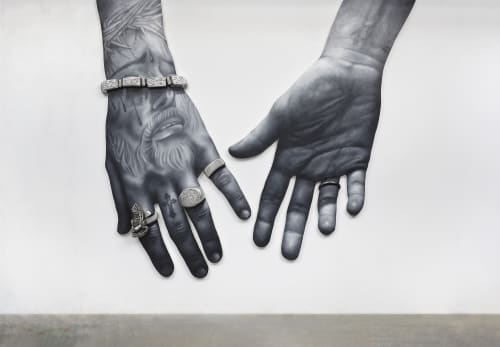In the early 1990s, when waves of change in identity politics swept through the art world, dozens of billboards featuring an unmade bed sprouted up across New York. Though the black-and-white image of an anonymous couple’s love nest may sound demure, the two dented pillows and a freshly folded blanket pierced passersby’s attention. The photo exuded unabashed intimacy, in public, and at a scale exclusively reserved for consumerist promotions.
On capturing public intimacy both as a political stance and bodily experience:
In our time and social/political climate, the body is rarely seen outside of a political context. For queer people, what is a bodily experience is, inevitably, simultaneously a socially political stance, or act. Queer public intimacy is political. As a lesbian in south Texas, I was taught to fear public displays of affection from day one. Kissing my girlfriend in public in Port Neches, Texas, could double as an act of love and as a political act of changing the culture.
The culture of a landscape has often directed how I felt and moved. In some places, I may feel politicized by my actions, in others, simply by my being. What I’m interested in is how I might pursue an alternative imagination of this sense of space, of what is public and what is private, if there is even the private.
On enlarging figures to a larger-than-life scale:
I’ve always felt humbled with a sense of respect toward large scale paintings and objects. Their impact always felt deliberate and meant to overwhelm you; to dwarf the viewer in comparison. Adding a layer of dimensionality onto something large scale sort of creates an immersive experience—a sense of community and, simultaneously, discomfort. All of this embodies what I would say is the queer experience: this coexisting sense of anxiety and comfort.
The scale and build of this work has been vital in creating a space for viewers to not only see each piece as a complex idea, but exist with it. To be brought into it. There is the reason to create a piece: to intrude on the viewer’s “personal” space, to allow it to physically and conceptually hold its ground; but, there is also the experience and labor I seek out in creating work at this scale and complexity.
“Within a queer context, there is nothing more public than privacy.”
Growing up an athlete, hard work and the hustle really structured my life. It fostered in me an insatiable desire to just work, to see how far I could go, how far my body could go, what I and my body could do. I relish(ed) in the pain that comes with pushing your body beyond its limits, and the ecstasy of making it out on the other side. This ability to push made me feel strong and powerful; it helped me to command a sense of respect in and for myself, and from others who, where I’m from, always placed the hardworking, physically strong boy on the pedestal. I feel this ties intimately into the relationship queer people have with their bodies, and how they are situated in the world.
We are extremely in tune—we notice the way our muscles move or look, how our shoulders line up with our hips (or lack thereof), how much space we take up, how our chests look in our clothes, etc. So, working at this scale is my way of creating an all-encompassing, rigorous experience—an experience relived or new—for myself and the viewer. It is my intention for this work to take up space, for the larger-than-life, almost monstrous figures to have a place where they fit, and for myself and the viewer to feel the mental, emotional, and physical labor that brought them—and these spaces—to life.
On the institution’s role today in representing queer intimacy today:
Within a queer context, there is nothing more public than privacy. When queer intimacy is made public at the institutional level, circulating as part of the public dialogue, it can be celebrated. And, when necessary, revisited. To have access to our own history and to the intimate lives of those who came before us, to be able to look into these histories and find artists, works, and moments that we can identify with, and to expand the range of conversations we have and the breadth of queer ideas explored—queer work and intimacy, in all of its forms, must be represented. Through exhibition and advocacy, I see institutions’ role today as one that is meant to ensure that the contributions of the LGBTQIA+ community are not forgotten.

